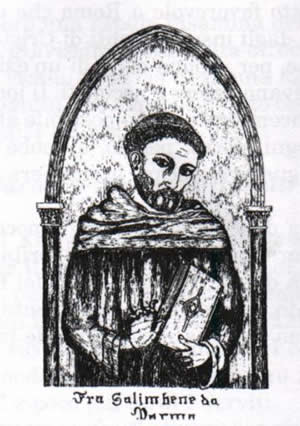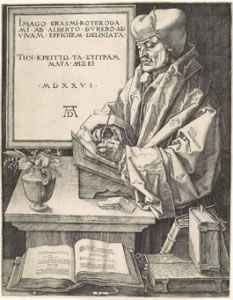Writers have always grasped both the positive and negative aspects of the ‘exceptional’ nature of Venice. They have loved it and hated it at the same time, though always describing it as exceptional and unique, totally different from all other cities, and a wonderful place where East and West meet.
One of the earliest Italian writers, Salimbene de Adam , a Mediaeval chronicler from Parma, provides us with a description of Venetian merchants that creates an image of Venice as a land of an arrogant, unscrupulous and corrupt people, a negative image that has persisted down the centuries alongside that of Venice as a land of freedom, equity and justice, with a strong oligarchic government ready to crush and dominate excessive behaviour.
In a tale in his "Decameron" (IV, 2) , Boccaccio calls the Venetians unfair, but always quick witted (see VI, 4), while he considers Venetian women stupid and vain.
Dante Alighieri , on the other hand, gives us a wonderful description of the Arsenale (Inferno, XXI, 7-15) in just three triplets, while Petrarca views the Venetian State as the ideal place for scholars. Erasmus of Rotterdam was of the same opinion: after spending a year in Venice, he described the city in a letter to Ambrogio Leoni as a place where he found true friendship and a sweet life. Then again, only a city like Venice that allowed freedom of thought could have guaranteed the safety of the many essayists who freely expressed their opinions, reflecting their various religious backgrounds, in the "Colloquium Heptaplomeres", a work attributed to Jean Bodin.
In other words, the basis for the Venetian Republic’s good reputation is the possibility it afforded for a free and peaceful coexistence of ideas, religions and philosophies. Indeed, the Republic actively promoted this image: public historians told of how Venice was a land of freedom, the most beautiful and salubrious setting for this, provided that all dues were paid to the State.
The clever solution leading to the happy ending of Shakespeare’s The Merchant of Venice is an eulogy to Venetian justice. The Bard unequivocally praises the merchant Antonio, a man respected for his noble heart and not on account of his lands or family, as most Venetians boasted, who for “reasons of trade” were first obliged to have dealings with the East before turning their attention to a political career.
The literary fashion for Academies spread from Venice in the 17th Century, the most famous example being the Glorie celebrated by Giovan Francesco Loredan’s Academia degli Incogniti. However Casanova’s Memoirs (with descriptions of the licentiousness of the city), Goldoni’s Comedies and Mémoires and Gozzi’s plays have left us a unique image of Venice, an image that, since the 18th Century, has indelibly linked Carnevale to a period of duplicity thanks to the mask, the wearing of which allows for multiple personalities, diversity and doubles. Although there is strong criticism in many of Goldoni’s plays of the expensive Carnival entertainments (especially gambling), the overriding image of the Venetian carnival is that of one big party, in the fantastic setting provided by the city’s architecture, with its reflections, dramatic escapes over the water and the mysterious gondolas.
Giovan Francesco Straparola’s Pleasant Nights is set during the carnival on Murano.
Indeed, this theme of Carnevale in Venice has become one of the most popular and successful, both in music (for example the folk tune entitled Carnival of Venice which also led to the Regatta poems) and in painting (especially, Pietro Longhi and Francesco Guardi).
Venice is also a point of departure and arrival for voyagers and so has been described by many travellers, from the Englishman John Mandeville in the 14th Century to more recent writers.
In the 1700s, the city became an important part of the "educational-cultural" Grand Tour as described by Ben Jonson in his satiric play "Volpone". Perhaps the most famous and most exhaustive description is that by Wolfgang Goethe in his "A Voyage to Italy", calling Venice “this beautiful island-city, this beaver republic”.
Schiller provides a different view of the city, as a hive of plots and full of hypocrisy. Ippolito Nievo’s "Confessions of an Italian" gives us another perspective, that of the end of the Serenissima and the occupation of the city by the armies of Napoleon followed by its annexation to Austria, resulting in the city’s losing its former world-standing. Camillo Boito’s "Senso" also deals with this aspect, later adapted into the wonderful film by Luchino Visconti .
Writers have also given us an image of decadent sadness: from John Ruskin’s "The Stones of Venice" to George Sand’s descriptions in her "Lettres d'un voyageur" and "Histoire De Ma Vie". This theme is common to many other contemporary travellers’ descriptions of the city and Aleardi’s highly romantic lyric poetry.
Henry James significantly uses Venice as the setting for his novels where a ‘manic’ passion is the main theme ("The Wings of the Dove" and "The Aspern Papers"). Venice is also the backdrop to stories of refined erotic passion (G. d'Annunzio and Frederick William Rolfe i.e. "Baron Corvo"). This image culminates in the corruption and depravation described in Thomas Mann’s Death in Venice , attracted by the fascination of beauty and death. Then there is Hoffmannsthal’s novel, "Andreas or The United" (“You must hide profundity. Where? On the surface”). Marcel Proust adds to this image of Venice in his "Recherche du Temps Perdu" (tomes: "La Prisonnière et La Fugitive": the setting for his intense jealousy of Albertine, an image replaced by that of his mother when Albertine dies).
The Futurist Marinetti also writes about Venice: he wants to fill in the Canal Grande and calls the gondolas "rocking horses for fools", good only for burning in a purifying fire. Venice is still a city of magic and charm, albeit suffering from some sickness according to Josif Brodskij in his "Fondamenta degli Incurabili". Eugenio Montale describes it as a place no longer worthy of the legends on which its fame is built (“a city attracting tourists and elderly lovers”) in his "Two Venetian Sequences, Satura II".
1100 - 1200 - - rev. 0.1.12













